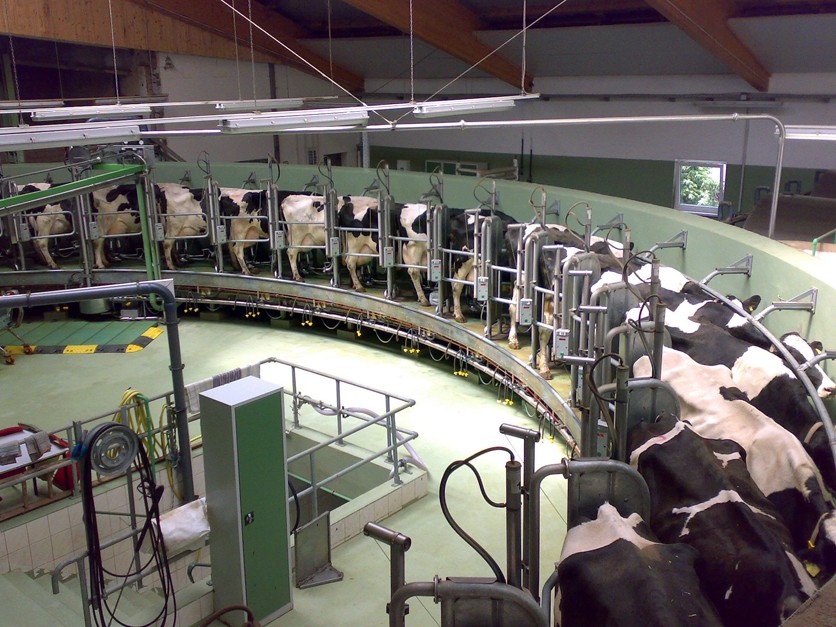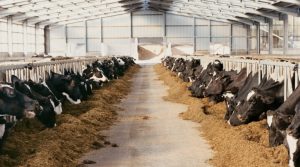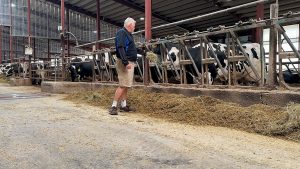
First, a look at some topline numbers. According to monthly data released by the U.S. Department of Commerce on Nov. 5, the value of U.S. dairy product exports for fiscal year (FY) 2021 (October 2020-September 2021) hit $7.394 billion, up 13% from FY 2020 and about equal with the previous record high of $7.4 billion in FY 2014. (The USDA and Department of Commerce also calculate the value of exports based on World Trade Organization definitions. Under those calculations, FY 2021 dairy exports totaled $7.319 billion.)
Despite those numbers, current logistical problems pose a permanent threat to U.S. dairy exporters, Mike Durkin, president and CEO of Leprino Foods, said during a U.S. House Agriculture Committee hearing on Nov. 3.
“The supply chain challenges have significantly impacted our business, and we don’t expect them to ease anytime soon,” Durkin said. “This export crisis may well result in irreparable harm to American agriculture as customers around the world are questioning the U.S. dairy industry’s reliability as a supplier.”
Durkin’s oral testimony, on behalf of the International Dairy Foods Association (IDFA), is available in a four-hour video of the hearing, beginning at about minute 49:15. His full written testimony is available here.
“The strain of shipping challenges is taking a heavy toll on dairy exporters,” said Krysta Harden, president and CEO of USDEC. “Dairy exporters are working hard to get American-made products to foreign customers in a reliable and affordable way, but the present situation can’t be sustained long term.”
“Dairy depends on exports, a vital part of the total demand for the milk produced every day by America’s hard-working dairy farmers” said Jim Mulhern, president and CEO of NMPF. “We risk damaging foreign market relationships and long-term customers if we cannot better assure efficient export flows.”
A look at September from USDEC
The USDEC provided an in-depth analysis of September 2021 dairy exports in its U.S. Dairy Exporter Blog:
Volume basis: Compared to year-earlier levels, September export volumes were up across all major dairy product categories, including: nonfat dry milk/skim milk powder (NFDM/SMP), up 16%; cheese, up 20%; butterfat, up 223%; whey, up 5% and lactose, up 6%.
Value basis: The news on the value side was even stronger. At $655 million, the value of September U.S. dairy exports was up nearly 28% from the same month a year earlier and nearly double the rate of volume increase. Average export unit values have climbed steadily in 2021, due to both strengthening dairy prices and a higher percentage of U.S. dairy exports coming from higher-value products, according to USDEC. The average price for a pound of milk solids exported by the U.S. reached its highest point since 2015, with the potential to go higher in the months ahead.
Milk solids basis: September 2021 exports on a total solids basis were estimated at 186,020 metric tons (MT), up 23,123 MT (14.2%) from the year before. Based on USDA preliminary September milk production estimates and Federal Milk Marketing Order (FMMO) butterfat and nonfat solids test results, Progressive Dairy estimates exports would represent more than 18.8% of total solids produced during the month.
In the blog, USDEC’s Stephen Cain, Paul Rogers and William Loux also provided updates on major U.S. dairy product importing countries:
U.S. dairy exports to Mexico have recovered in the past year, likely being driven by continued economic recovery, a tighter domestic milk supply and U.S. dairy product movement being diverted away from congested U.S. ports and shipped via truck and rail.
U.S. milk solids exports to the Middle East-North Africa (MENA) region in the first three quarters of 2021 have already exceeded the entire 2020 calendar year total.
Over the last 12 months, China’s dairy product imports (from all suppliers, not just the U.S.) grew by 29% – equivalent to growth of more than 600,000 MT of milk solids. While still relatively small, the U.S. share of that market has grown, with September year-over-year volume up 28%.
CWT-assisted exports
The NMPF updated Cooperatives Working Together (CWT) program-assisted sales. Through October, accepted offers on 2021 sales have reached about 38.3 million pounds of American-type cheeses, 13.3 million pounds of butter, 6.1 million pounds of anhydrous milkfat, 44 million pounds of whole milk powder and 11.3 million pounds of cream cheese. These sales are the equivalent of about 1.228 billion pounds of milk on a milkfat basis. The latest report includes revisions from previous reports. CWT estimates are based on contracts for delivery, not completed export volumes.
Hay exports slip from August highs
U.S. hay exports weakened slightly in September but remained strong in light of ongoing logistical challenges.
Alfalfa hay exports totaled 254,820 MT in September, a 45,000 MT decline from August. Most of the drop can be attributed to lower sales to China, but exports there were still the second-highest monthly volume on record and represented about 62% of total U.S. alfalfa hay sales for the month.
At 100,696 MT, September exports of other hay slipped to the second lowest monthly total for the year. Sales to the leading market, Japan, increased, but shipments to four other major buyers, South Korea, Taiwan, China and the United Arab Emirates (UAE), were all down slightly from August.
For more on hay exports and market conditions, check out Progressive Forage’s Forage Market Insights update.
Dairy heifer exports could finish year stronger
A large shipment of replacement dairy heifers to Pakistan pushed September exports to the highest total since June. A total of 2,541 dairy heifers were exported during the month, with 2,240 of those shipped to Pakistan. The remaining heifers went to Mexico (218) and Canada (83).
Year-to-date (YTD) dairy heifer exports total 15,268, the highest number for the January-September period since 2018. The YTD total may be slightly inflated, since a small shipment of animals, recorded as dairy replacements by the USDA, was actually made up of Brahman cattle, according to cattle exporters.
Tony Clayton, Clayton Agri-Marketing Inc., Jefferson City, Missouri, expects dairy replacement export numbers to be stronger to end the year. Large shipments are already planned for Pakistan, Vietnam and Turkey, making those countries larger customers than both Mexico and Canada. Clayton’s company is also shipping a load of Holstein bulls to Bangladesh in late November.
Sourcing U.S. dairy heifers for export continues to be a challenge, especially east of the Mississippi River, as more producers switch to using beef semen on a portion of their herds, Clayton said.
Additional barriers relate to some of the same challenges facing other ag commodity exporters. Higher fuel prices and a lack of trucks are affecting movement of cattle to U.S. ports and are creating price “sticker shock” for international buyers.
On the global market, prices for cattle sourced from Europe are also higher, so potential buyers from the Middle East are at least “kicking tires” in the North American market, Clayton noted.
Other trade news
Here’s a summary other issues about and affecting U.S. dairy and agricultural trade:
Despite dairy’s strong showing, the U.S. turned in an agricultural trade deficit for a fourth consecutive month.
The IDFA formed a Supply Chain Task Force to develop dairy trade policy recommendations.
USDA-sponsored, face-to-face trade missions will resume in February 2022 with a trip to the UAE. The last USDA-sponsored trade mission was held in November 2019, prior to COVID-19-related travel restrictions.
NMPF and USDEC filed comments with the U.S. Trade Representative’s (USTR) office outlining tariff and nontariff barriers to U.S. dairy exports.
Schreiber Foods, headquartered in Green Bay, Wisconsin, was honored as U.S. Dairy Exporter of the Year.
According to Rabobank, a fifth consecutive year of declining birth rates in China means sales strategies to the largest infant formula market in the world must change.
The Senate confirmed Cindy McCain as U.S. Representative to the United Nations (U.N.) Agencies for Food and Agriculture. U.N. food agencies, including the Food and Agriculture Organization (FAO), play a key role in setting global standards for food through Codex Alimentarius and other programs.
Agriculture leaders from across major food and ag associations formed the Agriculture Trade Education Council (ATEC), a nonprofit organization that will be a resource for education on the value of agricultural trade policies, practices and structures. Representing dairy is Becky Rasdall of the IDFA.
The Association of Equipment Manufacturers said a U.S. and European Union agreement to ease tariffs on steel and aluminum will help address steel shortages and soaring prices that have hurt agricultural equipment manufacturers, while also preventing Chinese steel entering the U.S. market from circumventing tariffs.
Citing fertilizer shortages and skyrocketing prices, U.S. organizations representing corn, soybean, cotton and sorghum growers urged the U.S. Court of International Trade to overturn an earlier decision by the International Trade Commission that imposed tariffs on imported phosphate fertilizers from Morocco.
The American Farm Bureau Federation reported that during the third quarter of 2021, 71% of exported containers from California were empty, as were nearly 50% of containers leaving Georgia and Virginia ports. Increased wait times and delays also disrupt domestic surface transportation networks, including the trucking and rail industries. In addition, average monthly import container costs for 2021 are up 18% at Los Angeles, 17% at Long Beach, 23% at Virginia and 22% at Savannah ports compared to the prior three-year average.























